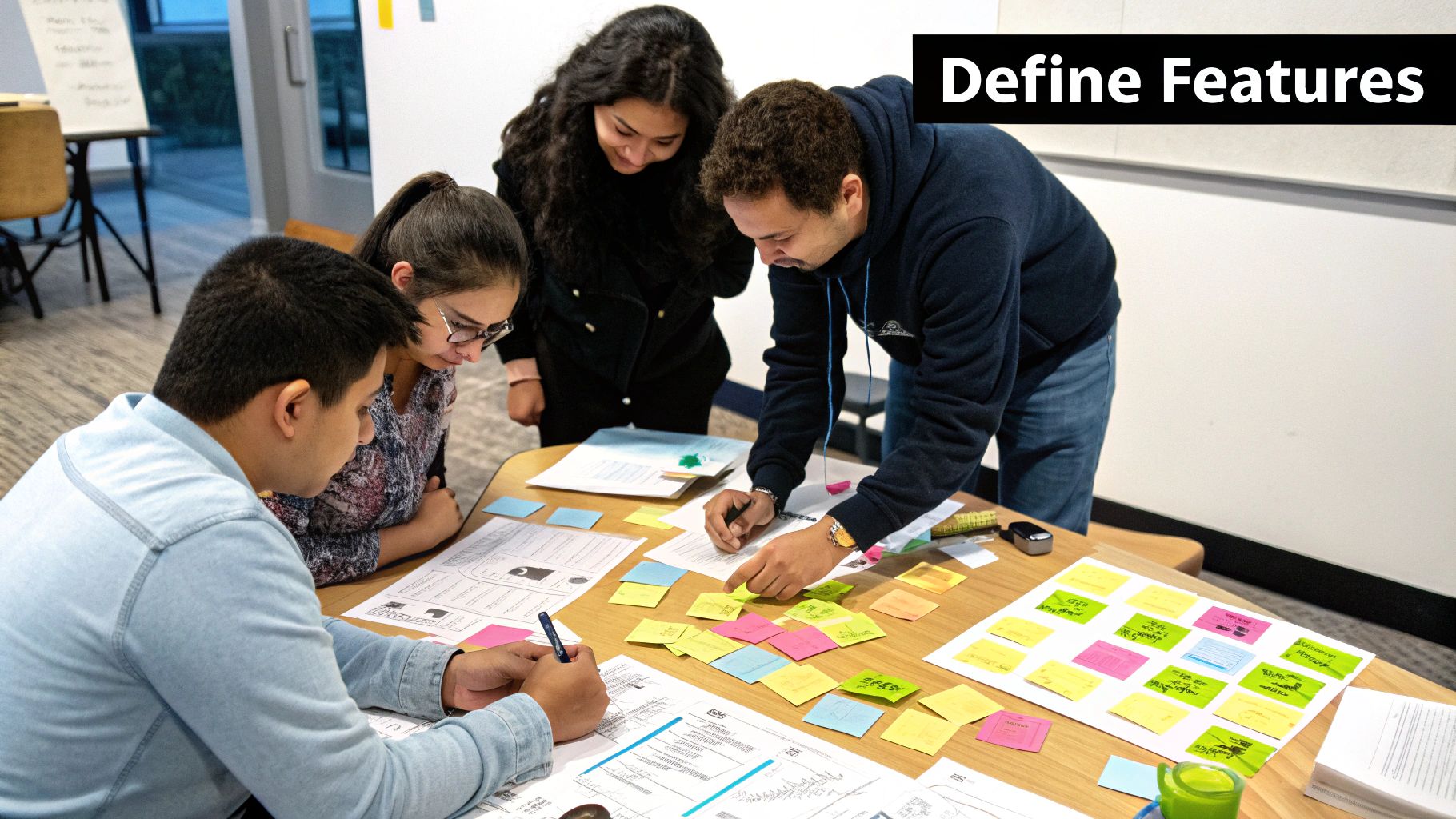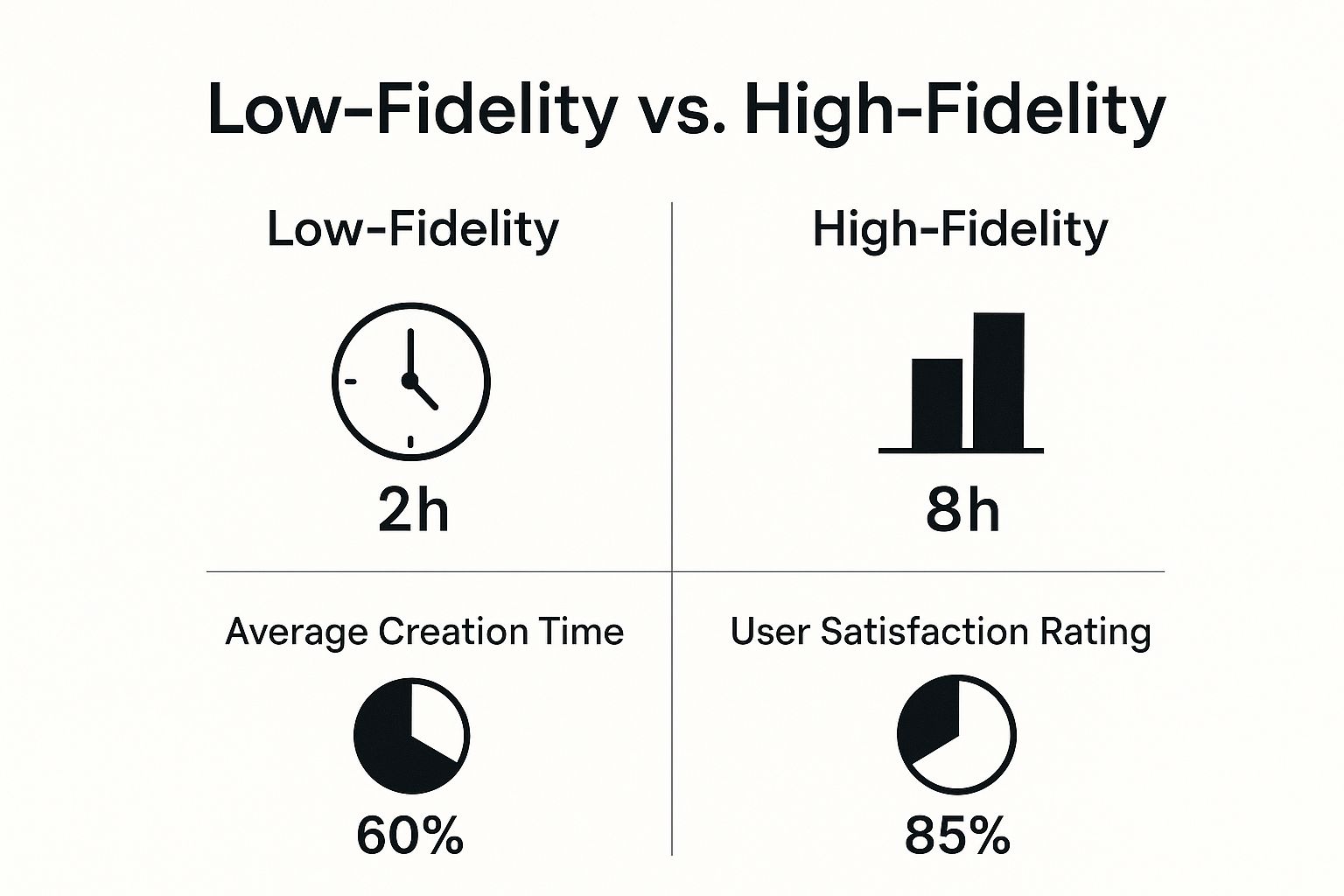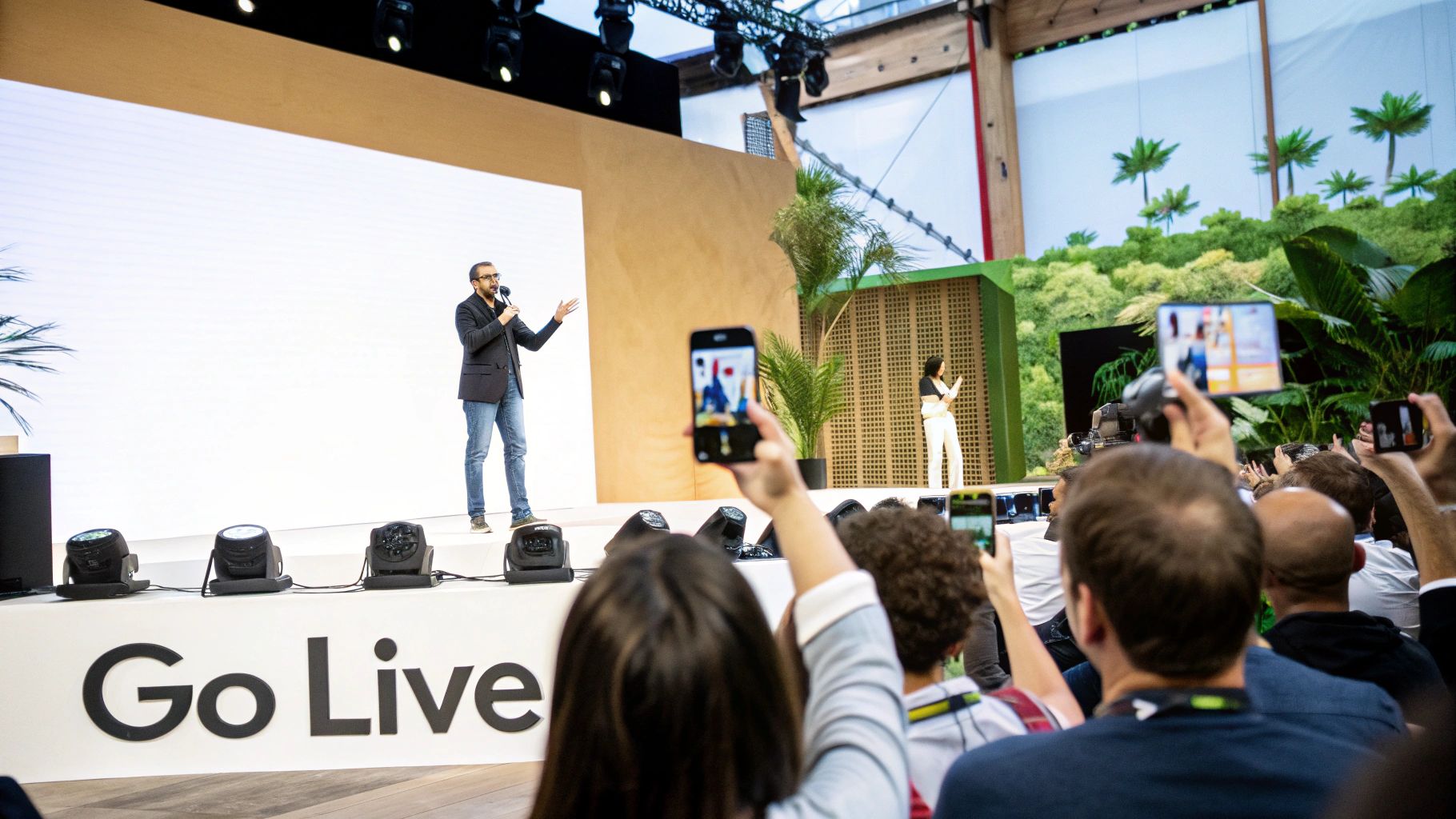Before you even think about writing a single line of code, you need a solid plan. It's the one thing that separates a brilliant idea that fizzles out from an app that actually succeeds. If you want to create a social media app that gets noticed, your first job is to find a specific community or niche that the big players like Instagram have overlooked. From there, you can build a project roadmap that makes sense.
From Big Idea to Actionable Blueprint

The journey to building a great social media app starts with strategy, not code. I know, the market looks completely saturated, but it’s also growing at a staggering pace. We've seen the global social media market jump from $252.95 billion to an estimated $286.53 billion in just a single year. That explosion is fueled by a massive cultural shift toward digital connection.
That kind of growth tells you there's still plenty of room for new apps, especially for those that aren’t trying to be the next Facebook. Your first real task is to find your own little corner of the internet. Don't build for everyone; build for a specific, passionate community. Think about groups that are currently underserved or using clumsy workarounds to connect.
The most successful new apps I've seen find a specific, underserved niche. Success comes from being the best solution for a smaller, passionate audience rather than trying to be everything for everyone.
Once you’ve locked in your target audience, it's time to define your Unique Value Proposition (UVP). This is your core promise. It’s the one thing your app will do better than anyone else for that specific group of people.
Defining Your Core Features And Roadmap
With your niche and UVP crystal clear, you can start outlining your Minimum Viable Product (MVP). This isn't the final, feature-packed version of your app. It’s the most basic version that solves the core problem for your target audience. I always tell people to list out every feature they can dream of and then ruthlessly sort them into three buckets:
- Must-Haves: These are the absolute non-negotiables for your MVP. For most social apps, this means user profiles, a content feed, and some way to post.
- Nice-to-Haves: These are features that would definitely improve the experience but can wait. Think things like direct messaging or fancy photo filters.
- Future Goals: These are the big, long-term ideas you can tackle once you have a solid user base. This is where monetization features or complex recommendation algorithms live.
To make this even clearer, I use a framework with my teams to map this out visually. It helps keep everyone aligned and focused on what truly matters for launch.
Core Feature Planning Framework
| Feature Category | Must-Have (MVP) | Nice-to-Have (Phase 2) | Future Goal (Phase 3) |
|---|---|---|---|
| User & Profile | Account Creation, Basic Profile | Profile Customization, Following/Followers | Verification Badges, User Analytics |
| Content | Text & Image Posts, Simple Feed | Video Uploads, Comments & Likes | Live Streaming, Ephemeral Stories |
| Community | - | Direct Messaging | Group Creation, Event Planning |
| Monetization | - | - | In-App Purchases, Ad Platform |
Using a table like this prevents "feature bloat" and keeps your initial development lean and focused. It forces you to make tough but necessary decisions.
This is also the perfect time to nail down your brand identity. Establishing clear https://getlate.dev/blog/social-media-brand-guidelines from the start ensures your app’s voice and visuals are consistent from day one, which builds trust.
Finally, you can pull all of this into a project roadmap. This is your timeline, outlining the key milestones from design and development all the way through testing and launch. It’s what keeps the team on the same page and gives you a clear path forward. If you need more detailed help with this part of the process, there's a great a step-by-step guide on how to create an application that breaks it down well. Trust me, this foundational planning is the most important investment you'll make in your app's future.
Designing an Experience That Hooks Users

The best social media apps don't just feel like software; they feel like an extension of your social life. This isn't an accident. It's the result of painstaking user experience (UX) and user interface (UI) design work aimed at one thing: creating an environment that people don't just use, but want to come back to.
It all starts with knowing exactly who you're building for. I'm not just talking about basic demographics. You need to go deeper and craft detailed user personas. These are fictional characters, born from your market research, that embody your ideal users. What drives them? What are they trying to achieve? And, most importantly, what frustrates them about the social platforms they already use?
From Personas to Prototypes
With your personas in hand, you can start mapping out their user journeys. A user journey is a visual storyline of how someone would navigate your app to get something done, whether it's posting an update or connecting with a friend. This simple exercise is gold—it lets you spot friction points and dead ends long before you've written a single line of code.
These insights flow directly into your wireframes. A wireframe is the stripped-down, skeletal blueprint of your app. It's all about structure, layout, and function—no colors, no fancy fonts. Think of it as the architectural plan before the interior designers arrive.
Next, you build an interactive prototype. This isn't the finished app, but it's a high-fidelity, clickable model that looks and feels like the real deal. It’s your first chance to put your core ideas to the test with real people and gather honest feedback.
A prototype isn’t just a demo; it’s a conversation starter. It allows you to test your core assumptions with real people, saving countless hours and thousands of dollars in development by catching design flaws before they become expensive coding problems.
Key Design Principles for Social Apps
When you're building a social app, a few design principles are non-negotiable if you want to earn user loyalty and keep them engaged.
- Intuitive Navigation: Users should never have to think about where to go next. A clean, predictable navigation bar—usually docked at the bottom of the screen—is a must-have for letting people switch between their feed, messages, and profile effortlessly.
- Seamless Interaction: Every tap, swipe, and scroll has to feel responsive and satisfying. Basic actions, like liking a post or sending a direct message, should be so fluid that they become second nature.
- A Strong Visual Identity: Your app needs a distinct personality that clicks with your target audience. This means a well-chosen color palette, consistent typography, and an icon style that says something about your brand.
At the end of the day, great design is about empathy. You can guess what users want, but to really know, you need data. This is where tools for Real User Monitoring (RUM) come in, giving you direct insight into how people actually behave inside your app. This data is what helps you move past assumptions and build an experience that truly hooks users.
Build faster with Late
One API call to post everywhere. No OAuth headaches. No platform-specific code.
Free tier • No credit card • 99.97% uptime
Choosing Your App's Technical Foundation
This is where the rubber meets the road. Picking the right tech stack is one of the most consequential decisions you'll make. It directly impacts your app's performance, how quickly you can build it, and how much it'll cost to keep running. This isn't just a decision for developers; as a founder, you need to understand the trade-offs.
Think of it like this: are you building a custom-designed house from the ground up, or using a high-quality prefabricated model? Both can result in a fantastic home, but they cater to very different priorities and budgets.
Your first big fork in the road is choosing between native and cross-platform development. Native development means building two separate apps: one for iPhones using Swift and another for Android devices using Kotlin. The result? The absolute best performance and a user experience that feels perfectly tailored to each device.
The catch, of course, is that you're building and maintaining two completely separate codebases. That gets expensive and time-consuming, fast. This is why cross-platform solutions like React Native or Flutter have become so popular. They let your team write code once and deploy it on both iOS and Android, which can slash development costs by as much as 40%. The trade-off can be a slight hit to performance or some limitations in accessing very specific, deep-level device features.
A Quick Look at Development Approaches
To help you decide which path makes sense for your app, here’s a breakdown of the three main approaches: native, cross-platform, and Progressive Web Apps (PWAs).
Development Approach Comparison
| Approach | Pros | Cons | Best For |
|---|---|---|---|
| Native (Swift/Kotlin) | - Top-tier performance - Seamless UX - Full access to device features | - Higher cost and time - Two separate codebases - Larger development team needed | Apps where speed and a premium, device-specific experience are non-negotiable. |
| Cross-Platform (React Native/Flutter) | - Faster time-to-market - Lower development cost - Single codebase to manage | - Potential for minor performance lags - Might have limits on certain native features | Most startups and MVPs where budget and speed are critical priorities. |
| PWA (Progressive Web App) | - No app store needed - Extremely fast to deploy - Works across all devices with a browser | - Limited access to device hardware - Can't be listed in app stores - Lower user engagement typically | Simple social tools or companion apps where broad accessibility is key. |
Ultimately, the choice comes down to your unique situation. If you have the funding and your app's core value is tied to buttery-smooth animations and deep OS integration, go native. If you need to validate your idea quickly and efficiently, a cross-platform framework is your best bet.

As you move from rough sketches to polished designs, user satisfaction skyrockets. Social apps live and die by their user experience, so don't skimp on the design phase.
Understanding the Backend Essentials
If the frontend is the beautiful car body, the backend is the engine, transmission, and chassis—everything that makes it go. This is what determines whether your app can handle 100 users or 100 million. To build something that can truly grow, you have to get a handle on some basic system design and architecture principles.
Your backend is really three core parts: a server, a database, and an API. For your server-side language, common choices are Node.js, which is fantastic for handling real-time things like chats and notifications, or Python, which excels at data-heavy tasks.
Then there's your database. The big decision here is SQL vs. NoSQL.
- PostgreSQL (SQL): This is your go-to for structured data with clear relationships. Think follower lists, user profiles, and tagged content. It’s reliable and predictable.
- MongoDB (NoSQL): This offers more flexibility and is built to handle huge amounts of unstructured data—like a chaotic stream of user posts, comments, and likes.
Your backend isn't just a nerdy detail; it's the foundation for your app's future. I’ve seen promising apps crumble because their backend couldn't keep up with their growth. A poorly planned backend leads to crashes and lag as more users sign on, so choose wisely from day one.
Finally, the API (Application Programming Interface) is the messenger that lets your frontend app talk to the backend server. A well-built API is critical for everything from logging in a user to fetching a feed of posts.
When you get to more advanced features, like letting users schedule content across different social networks, you can integrate specialized tools. Taking the time to understand how a unified social media API works can give you a massive leg up, saving you from reinventing the wheel and letting you add powerful features much more efficiently.
Alright, you've got your tech stack sorted out. Now for the fun part: building the features that will actually make your social media app feel alive and engaging. This is where we shift from technical blueprints to creating the tangible, interactive elements that define the user experience. Get this right, and people will stick around.
The goal here is to build a seamless home for connection and self-expression.
Everything kicks off with a secure and dead-simple entry point. User authentication is your app's front door, and a clunky, multi-step sign-up is the fastest way to lose potential users before they've even seen what you've built. I've learned this the hard way. Always offer multiple sign-up options: classic email/password is fine, but you absolutely need one-click social logins like Google or Apple. It's a small detail that shows you respect the user's time and dramatically cuts down on sign-up friction.
Once they're in, users need a little corner of the app to call their own. A customizable user profile isn't just a data entry form; it’s their digital identity on your platform. At the bare minimum, you need a profile picture, a display name, and a short bio. Giving users this control is the first step in making them feel like they belong.
Engineering a Dynamic Content Feed
The heart of any social app is the feed. This is where your users will live and breathe, so it has to feel dynamic, relevant, and fast. For an MVP, a straightforward chronological feed showing posts from accounts the user follows is a fantastic starting point. It’s predictable, easy for users to grasp, and frankly, much simpler to build initially.
From day one, your app needs to handle the core content types people expect:
- Text Posts: The classic. Perfect for quick updates, questions, and sparking conversations.
- Image Uploads: Visuals are everything. Make sure your app handles image uploads efficiently, and don't forget about compression—it's key to keeping load times snappy.
- Video Content: In today's market, this is completely non-negotiable. Even supporting short video clips is an absolute must-have for a modern social app.
Building these features isn't just about making them work. It's about performance. A slow, janky upload process will kill a user's motivation to post anything at all.
Fostering Real-Time Interaction
A social app without interaction is just a glorified blog. To truly build a community, you need to give people tools to connect with each other. This is where likes, comments, and private messaging become critical.
A "like" is more than just a counter; it's a low-effort, high-impact social signal that validates the user who posted. Comments create conversation, and direct messaging provides a space for deeper, private connections. These three features are the foundational pillars of engagement.
It's crucial to make these interactions feel instantaneous. When someone likes a post or sends a message, that feedback needs to be immediate. This demands a solid backend that can process these real-time events without any noticeable lag, which is what makes the app feel responsive and alive.
The scale of this challenge is immense when you realize you're competing for attention in a market of over 5.04 billion active social media users worldwide. Giants like Facebook and Instagram have set incredibly high expectations for what a smooth user experience feels like.
Remember, every single feature you build should tie back to the core purpose of fostering connection. If you're looking for more advanced strategies on this, our guide offers some great tips to boost social media engagement and keep your users hooked.
Turning Your App Into a Sustainable Business

Let's be real: a brilliant app idea without a business model is just a passion project. If you want to create a social media app that actually sticks around, you need a smart way to make money. The obvious route is plastering it with banner ads, but that’s a quick way to annoy your users and kill the experience.
A much better approach is to offer things that add real value. Think about in-app purchases for digital goods—custom profile themes, exclusive sticker packs, or cool video effects. This model works because it’s entirely optional. Your most dedicated users get to buy things they actually want, and everyone else's experience isn't compromised.
Another rock-solid strategy is a tiered subscription model.
A well-designed subscription tier shouldn't just be about removing ads. It needs to unlock powerful, exclusive features that your core users will happily pay for—think advanced analytics for creators, priority support, or early access to new tools. This turns monetization into a value-add, not a penalty.
These models create a predictable revenue stream without pushing away your casual user base.
Building Your Launch Playbook
Once you’ve got a monetization plan, it's time to map out your launch. This isn’t about just flipping a switch; it's a careful process designed to build momentum and get you priceless feedback. Before you even think about hitting the app stores, you need to run a closed beta.
A closed beta is where you invite a small, hand-picked group of your ideal users to test the app. Their feedback is pure gold. It helps you find and squash bugs, refine confusing features, and get everything polished before the general public lays eyes on it. After you’ve worked out the biggest issues, you can move on to an open beta or a soft launch.
Here’s a simple game plan for a launch that gets results:
- Generate Pre-Launch Buzz: Start talking about your app on relevant social media channels weeks ahead of time. Share sneak peeks of the UI, write about the development process, and maybe start a waitlist to collect emails. You want to build a sense of anticipation.
- Navigate the App Stores: The submission process for Apple’s App Store and Google Play can be a minefield. Both have strict guidelines, so read them carefully. Your app description needs to be compelling, your screenshots have to look professional, and you need to nail your keywords so people can find you.
- Plan for User Acquisition: Don't assume users will just flock to you on day one. Have a plan ready to go. This could be anything from running targeted social media ads and collaborating with influencers in your niche to pitching your app to tech blogs. Launch day isn't the finish line; it’s the starting line for growth.
Answering the Big Questions About Building Your App
Jumping into app development always stirs up a lot of questions. When you're dreaming up a new social media app, those questions can feel even more daunting. I've been there. Let's tackle some of the most common hurdles that founders and developers run into.
How Much Does It Really Cost to Build a Social Media App?
There's no magic number here. The cost to create a social media app is all over the map, depending on how complex it is, what features you absolutely need, and where your development team is based.
For a lean Minimum Viable Product (MVP) with the essentials—think profiles, a simple feed, and basic posting—you're likely looking at a range between $25,000 and $75,000. That gets your idea off the ground and into the hands of real users.
But if your vision includes custom algorithms for content discovery, live streaming capabilities, and sophisticated moderation tools like the big players have, the budget can quickly soar into the hundreds of thousands. The smartest move? Start with a focused MVP. Prove your concept, get some early adopters, and then you can justify a bigger investment.
How Long Does the Development Process Take?
Building a great social app is a marathon, not a sprint. A well-executed MVP usually takes about 4 to 8 months from the initial spark of an idea to launch day.
This timeline isn't just coding. It's a whole process that includes:
- Discovery & Strategy: Nailing down your niche and defining the core features.
- Design (UX/UI): Sketching out wireframes, building interactive prototypes, and creating the final look and feel.
- Development: The actual front-end and back-end coding.
- Testing & QA: Hunting down bugs and making sure the experience is rock-solid.
- Deployment: Navigating the App Store and Google Play submission process.
If you start adding more advanced features or need a heavy-duty backend, that timeline will naturally stretch. Patience and a realistic roadmap are your best friends here.
How Can a New Social App Compete with Giants?
Here’s the secret: you don’t. Trying to go feature-for-feature against giants like Facebook or TikTok is a recipe for disaster. The new social apps that actually succeed do it by carving out a specific, underserved niche.
Don't build for everyone; build for a passionate few. Success comes from being the absolute best solution for a smaller, dedicated community. Focus on a unique type of interaction, a specific content format, or a shared interest that larger platforms ignore.
Think of it like this: you’re not building another giant public square. You're creating an exclusive, cozy clubhouse where your members feel like they truly belong. This niche-first approach is how you build a loyal, passionate user base from the ground up.
What Are the Biggest Legal Risks to Consider?
Two major legal minefields you need to navigate carefully are data privacy and content moderation. First, you have to be completely compliant with data protection laws like GDPR in Europe and CCPA in California. These regulations have strict rules about how you collect, store, and handle user data.
Second, you need a bulletproof plan for moderating user-generated content. That means having crystal-clear Terms of Service, an easy way for users to report harmful stuff, and a process for handling everything from copyright claims to hate speech. This isn't just about avoiding lawsuits; it's about protecting your users and your business.
Considering that people spend a collective 14 billion hours daily on these platforms, as highlighted in recent social media statistics, engagement is both your biggest opportunity and your biggest responsibility. Getting this right is non-negotiable.
Ready to build the scheduling and content distribution features for your new social media app without the headache of multiple integrations? Let LATE handle the complexity. Our unified API lets you connect to seven major platforms with one simple integration, saving you months of development time. Start building for free with LATE today!